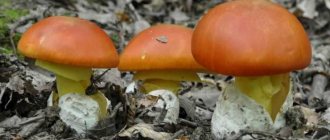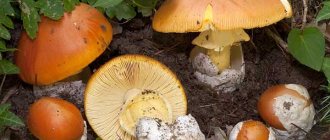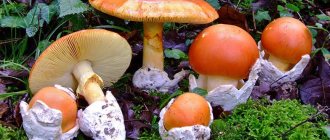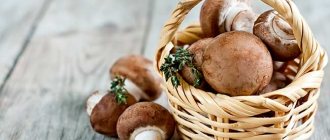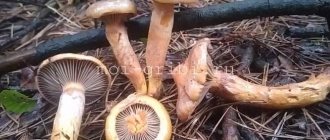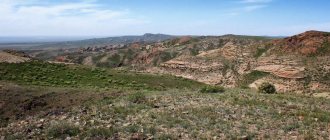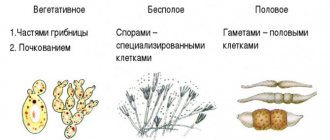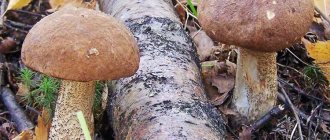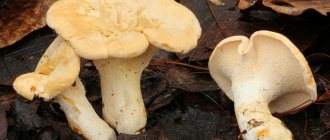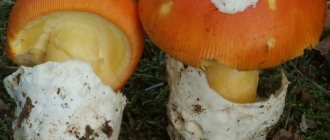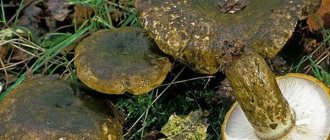The royal mushroom is a species of the Amanitaceae family. The representative of a huge kingdom has other names: Caesar's mushroom, royal fly agaric, Caesar's mushroom. Amanita Caesar belongs to the edible category, has excellent taste and is an extremely valuable product.
The imperial specimen has poisonous and deadly relatives. When collecting, young specialists should be very careful. Another interesting name that the representative has is egg mushroom. Combines a number of beneficial properties and healing qualities.
Application
Due to the fact that the existence of the Caesar mushroom was known more than 2000 years ago, its beneficial and dangerous properties have been carefully studied.
This species does not contain or accumulate hazardous or toxic substances, so it is not capable of harming human health and well-being. At the same time, the unique composition of vitamins and microelements makes it a useful and even medicinal food product. The raw product has low calorie content, a minimum of fats and carbohydrates, but a balanced combination of valuable animal and vegetable proteins.
In addition, the following important elements were found in the composition:
- B vitamins;
- vitamins of group A;
- vitamins of group D;
- vitamins of the PP group;
- ascorbic acid;
- Apple acid;
- fumaric acid;
- succinic acid;
- lemon acid;
- alpha-ketoglutaric acid;
- potassium;
- sodium;
- manganese;
- iron;
- selenium.
In folk medicine, fly agaric extract is used as a means to combat malignant tumors. In addition, many experts are confident that eating egg mushroom reduces the risk of cancer, problems with the prostate gland in men and effectively treats atherosclerosis.
It has been proven that people who often include Caesar mushroom in their diet become more stress-resistant, less at risk of cardiovascular diseases, and feel cheerful and productive. Royal fly agaric tincture is used for rheumatism, arthrosis, and to reduce pain in the joints.
Having a rich chemical composition, Caesar mushroom is a godsend for such areas as medicine, pharmacology, cooking and cosmetology. It is difficult to say where his role is more important. These areas are in many ways related and use Amanita Caesar widely.
In cooking
It is easy to prepare as it does not require pre-processing. While the Caesar mushroom has not yet completely grown out of its shell (one might say, it is in the egg stage), cooks often add it raw to various salads. The royal mushroom can be fried, baked or simply dried. This is a low-calorie food with 22 kcal per 100 g.
Calorie content per 100 g:
- carbohydrates – 3.26 g;
- proteins – 3.09 g;
- fats – 0.34 g;
- fiber – 1 g;
- 0.85 g of inorganic substances.
Medicinal properties
The benefits and harms of this mushroom have already been well studied. Since this mushroom does not contain toxic substances, it cannot cause signs of poisoning or other adverse effects. Using this variety for food can bring great benefits to the human body. This product is low calorie. 100 g of product contains no more than 19 kcal. In addition, the pulp contains small amounts of carbohydrates and fats. This product is high in protein. The active acids present in the mushroom pulp include:
- ascorbic acid;
- alpha-ketoglutaric;
- apple;
- fumaric;
- lemon;
- amber.
This fruiting body contains a high content of vitamins B, A, PP and D. In addition, the pulp is an important source of selenium, potassium, sodium, manganese, iron and some other elements. From edible fly agarics grown under artificial conditions, scientists isolate ergosterol, which is later used to obtain the vitamin. In addition, it was found that the fruit body contains a compound that has an inhibitory effect on staphylococcus and Bacillus subtilis.
These mushrooms contain many vitamins
Traditional healers use an extract of this mushroom to treat cancer. In addition, it is believed that regular consumption of edible fly agaric mushrooms reduces the risk of developing malignant tumors. In some regions, a tincture of this mushroom is used to rub joints for diseases such as rheumatism, arthrosis and gout. Regular inclusion of the royal fly agaric in the diet helps eliminate atherosclerosis.
Description of the mushroom
The cap of the Caesar mushroom (lat. Amanita caesarea) has a regular rounded shape. In young specimens it is hemispherical, but as it grows it becomes flat; grooves form at the edges in adult specimens. The size of the cap can be from 8 to 20 cm. The plates are frequent, widened in the middle, and overgrown with fringe along the edges.
Did you know? In Ancient Rome, this mushroom was one of the favorite delicacies among the nobility and was called boleti. From those times (about 2000 years ago) such a noble name “Caesar” originates.
The stem has a diameter of 2-3 cm, and its height often coincides with the diameter of the cap. It is club-shaped, slightly widened at the base. A distinctive feature is the protective cover. There is a volva, 5-6 cm wide, and a ring of the same color as the stem. The blanket performs a protective function.
At the initial stages of growth, it effectively protects the fruiting body from environmental influences. Then it opens slightly and protects only the leg (1/2 or 2/3). But it happens that even in adult fetal bodies the veil reaches the cap in the form of large scales. The spores are wide, white (sometimes with a slight gray or yellow tint), and frequent.
What does it look like
The cap of a young Caesar's fly agaric has an orange or fiery red color, but as it matures and in the process of withering, it becomes yellow. The plates are orange-yellow in color. The pulp is juicy, aromatic, and has a characteristic hazelnut smell. It is dense, strong, and white. The peripheral layer of pulp is yellow-orange.
The leg is fleshy, yellow in color. This mushroom is very easy to confuse with the red fly agaric, especially when rain washes off the white flakes from the poisonous fruiting body.
Did you know? The caps of the royal mushroom are almost always orange or red in color, but sometimes mushroom pickers encounter completely white specimens. Some experts classify them as a separate species, but most do not share this opinion.
Where does it grow
Caesar mushroom is very common and grows well in many climate zones. Most often, Caesar's fly agaric is found in deciduous forests: at the base of birch, oak and hazel trees. Prefers places with good lighting and acidic decalcified soil composition. The royal fly agaric can be found in Central and Southern Europe, partly in North Africa, as well as in the Crimea, Transcaucasia, Transcarpathia and Primorye. In Ukraine and Germany it is listed in the Red Book.
The egg fly agaric has a close relative, practically a twin, known as the Far Eastern Caesar mushroom. Their external and taste characteristics are absolutely identical, the only difference is in the distribution area - based on the name, the second grows in the deciduous forests of the Far East
Edible or not
Caesar's mushroom is an edible and safe fly agaric. It is very tasty, aromatic and healthy when consumed in moderation. However, you need to be as careful as possible so as not to confuse it with its poisonous counterparts.
Important! Old and overripe fruiting bodies have a very unpleasant smell of rotten eggs (in fact, it smells like hydrogen sulfide) and mushroom pickers do not collect them. Such mushrooms are completely safe for humans, but their taste and smell are repulsive
Caesar's fly agaric and pale toadstool: differences.
Be careful not to confuse the Caesar mushroom with the toadstool. The fact is that in the egg stage they can be similar. How are these mushrooms different?
Firstly, the cap of the king mushroom is reddish-orange, while the cap of the pale toadstool is white or green. Below you can see the growth stages of the toadstool.
Pale toadstool - a poisonous mushroom
Secondly, in the “egg” stage, the pale grebe and the royal fly agaric differ when cut into pieces. The edible caesarean mushroom has a yellow cap (see photo below), while the toadstool has a white cap.
On the left is a poisonous pale toadstool in cross-section, on the right is an edible fly agaric of Caesar
Appearance of the mushroom
This mushroom belongs to the Amanitaceae family, genus Amanita and species Amanita caesarea. Despite such a formidable name of the family and the presence of very dangerous relatives, it is edible and belongs to the category of special delicacies, popular even at the feasts of the nobility in the Roman Empire. It is also called “Caesarean fly agaric”, “royal mushroom”, “royal fly agaric”, “Caesar’s fly agaric”.
In appearance, its fruiting body resembles a typical red fly agaric, especially after rain, when the characteristic white flakes remaining from the general cover are washed off from the cap of the poisonous fly agaric. The difference between them is also visible in the color of the legs. In the poisonous mushroom it is white, while in the royal mushroom it is yellow. The white color is unique to the Volva, which resembles a broken eggshell.
The color of the cap can be either bright red or orange-golden. If the mushroom is already old, then the color of its cap fades. At first it has a hemispherical shape, later it levels out and becomes slightly convex. The hymenophore is lamellar, yellow or orange.
The mushroom begins to develop inside that same white egg-shaped shell, which subsequently encircles its stem. It grows quite large, and the cap has a diameter of up to 20 cm. The club-shaped leg of this mushroom is fleshy and strong, measuring from 5 to 20 cm in height and from 1.5 to 5 cm in diameter. Its flesh is white, but its surface layer is yellowish-orange.
Places of growth
Caesar's mushroom grows in many countries with varied climates. You can meet it both in the deciduous forests of Transcarpathia and Crimea, and in Africa. It is found in the Caucasus and America, in European countries such as France, Italy, Germany and Spain. To a greater extent, it is classified as a heat-loving mushroom, since it is common in temperate regions and in the Mediterranean subtropics.
Irina Selyutina (Biologist):
Caesar's mushroom has never been found in the northern zone in Russia. This species prefers light forests and is found in July-November. It is believed that the average temperature should be about +20℃ and at the same time last 2-3 weeks during the period of its appearance.
For the Caesar mushroom, forms are known that in their color (cap, other structural details) deviate from the main form. A white variety of this species has been discovered in China for quite some time. It is described as a form of Amanita caesaria f. alba (Gillet) EJGilbert, but since, as experts point out, such mushrooms are usually found next to normally colored specimens, the existence of this independent form is called into question.
Doctor of Biological Sciences, Russian mycologist L.N. Vasilyeva (02/15/1950-02/23/2017) described the Far Eastern Caesar mushroom, which she named Amanita caesareoides. Its differences from the main form are as follows:
- Volva: painted yellow inside; has a special yellow cup (pedunculated volva) 3 cm high in large fruiting bodies.
- Hat: there are no scraps of cover on the surface (naked), and there is a wide low tubercle in the center.
The fact that the royal mushroom is a valuable organism is proven by its inclusion in the Red Books of Ukraine and Germany.
Interesting Facts
In the Roman Empire, Caesar's fly agaric was called “boleti” and was revered as the highest grade of mushroom (“fungorum princeps”). This type of fruit was especially glorified by the general Lucullus, a great gourmet, whose grandiose feasts impressed his contemporaries and became the talk of the town. The imperial delicacy was also believed to heal wounded soldiers.
Ancient literature contains mention of this exquisite product - in the pathetic “Satires” of Juvenal Decimus Junius. He wrote: “Poor friends are served other mushrooms, of an unimportant variety, but the owner is sick.”
Today, scientific nomenclature uses the name "boletus" to designate the Borovikov genus.
The widespread use of cesarean mushroom is due to its special taste and a large list of beneficial properties. It is also actively used in dietetics, pharmacology, cosmetology and traditional medicine.
Growing methods
According to the description, the Caesar mushroom is not one of those fruiting bodies that are popular among those who like to grow mushrooms in their summer cottage, since the conditions for this should be close to those in which it grows in forests. In addition, you need to wait more than one year for the Caesar fly agaric to grow. For the right environment, the site needs to have trees such as chestnuts, birches, oaks, with mushrooms associated with their roots.
There are several ways to grow it. A sign that the planting has taken root are the mycelium threads at the planting site, which are white. It is better to use old mushrooms for planting.
Landing plan:
- Bury the ground fly agarics under the roots of trees, but not deep.
- Scatter pieces of mushrooms near the desired trees, cover with foliage and water regularly with warm water.
- Transplant fly agarics from the forest.
- Prepare planting material. To do this, mushrooms are crumbled into a bucket, filled with rainwater, after which the bucket is kept at a temperature slightly above 20°C for 2 days. Next, the contents of the bucket are poured onto a planting site that meets the necessary conditions.
Video
Sources
- https://tutknow.ru/meal/9283-cezarskiy-grib.htmlhttps://nashzeleniymir.ru/caesar-mushroomhttps://www.wday.ru/dom-eda/soh/ischem-i-gotovim-tsezarskiy- grib/https://fermoved.ru/gribyi/cezarskij-muhomor-cezarya.htmlhttps://xcook.info/product/cezarskij-grib.html
Cooking rules
This delicacy belongs to the highest category, so if you are lucky enough to find it, then it is advisable to know how to prepare it correctly and tasty.
Very young Amanita caesarea are consumed raw, but grown ones have a choice: fried, baked, dried, pickled. Both caps and stems are used in cooking. Powder is obtained from dried products. Properly prepared pickled caps will be very tasty. The product withstands freezing well both in its pure form and as part of semi-finished products.
Caesar's fly agaric dish
An amazing fact is that in the traditions of preparing Caesar, it was not recommended to wash it, but only to clean it of debris with a slightly moistened sponge. It was believed that when washing, a certain amount of nutrients and taste is lost.
How to cook?
Every housewife who has at least once prepared forest delicacies knows how long to cook mushrooms. In this case, the same principles are used during processing: after boiling, the first water is drained, and the fruiting bodies continue to be cooked in the second water for 25-30 minutes. The water after cooking is drained and is not used in recipes.
Recipes using egg mushroom
The egg mushroom gives the dish a unique taste and aroma. Let's look at the most interesting dish recipes:
Mushrooms in puff pastry. You will need:
- chicken fillet – 200 g;
- edible fly agarics – 200 g;
- eggs – 5 pcs.
- hard cheese – 100 g;
- puff pastry - 1 package;
- salt, spices, herbs to taste.
Mushroom roll
The meat and mushrooms are chopped and fried in a frying pan, the egg-cheese mixture is poured on top and fried for 5 minutes. This filling is placed on a sheet of puff pastry and wrapped into a roll. Place in a hot oven for 30 minutes at 180 degrees.
- onions – 2 pcs.;
- Caesar - 500 g;
- potatoes – 7 pcs.;
- carrots – 1 pc.;
- eggs – 2 pcs.;
- salt, spices to taste.
- Caesar - 300 grams;
- onions – 2 pcs.;
- sweet pepper – 2 pcs.;
- eggs – 2 pcs.
Interesting information
Even in ancient times, people considered the presented delicacy to be an exquisite delicacy. It was not only baked, but also fried over an open fire and dried for the winter.
- Interesting information
- Natural healer
- Culinary use
- Tips for gourmets
- Cooking on ketsi
If quiet hunters managed to find a family with “cubs,” they were cut off without damaging the Volva, and then sent to salad without prior heat treatment. But here you should be extremely vigilant, since in this form their description is almost identical to the babies of the pale grebe. Only a cut test can prevent disaster, since the forest inhabitants are completely different inside.
Despite the fact that the world knows this representative of the flora as Caesar’s mushroom, the great commander’s contemporaries themselves preferred to call it “boleti”.
Another clue for those who still have difficulty distinguishing edible representatives from false ones is the habitat. Knowing where this delicacy grows, you will be more confident in putting it in your basket. Most often it can be found under oaks, beeches, chestnuts in deciduous or mixed forests.
Natural gifts prefer dry places where it is warm and sandy soil predominates. Initially, they delighted North African gourmets from Mexico, and more recently they have been spotted in Georgia, Russia, Ukraine, and Azerbaijan.
Harm and contraindications to the use of Caesar mushroom
Despite the voluminous list of beneficial properties, only a limited amount of Caesar mushroom can be eaten. Its frequent and uncontrolled activation can negatively affect health and cause serious malfunctions.
Consequences of abuse of Caesar mushroom:
- Manifestation of an allergic reaction - redness and irritation on the skin, dizziness, fainting, stomach upset, flatulence, stool disorders, nausea, vomiting, the sclera of the eyes turn yellow, apathy appears, changes in blood pressure, vital energy disappears, the mucous membranes become covered with abscesses.
- In women, the menstrual cycle may be disrupted - severe pain in the lower abdomen, headaches, and there is a high risk of developing endocrine disorders.
- Frequent urination - the bladder becomes toned, excessive irritability appears, sleep patterns are disrupted, and calcium is washed out of the bones.
- Inflammation of the liver and kidneys - the mucous membranes are susceptible to negative effects, and glomerular nephritis may develop.
Caesar mushroom must be collected away from highways, since it, like a sponge, absorbs pathogenic microflora and toxins through the ground. Also, they should not be abused for epilepsy, as there is a risk of triggering an attack.
Absolute contraindications to Caesar mushroom:
- Urolithiasis - there are problems with urination, vomiting, pain in the kidneys, blood and sand in the urine, the microflora of the gastrointestinal tract worsens.
- Gout - metabolic failure, tremors of the limbs, frequent convulsions are observed, salt build-ups appear on the arms and legs, and physical activity decreases.
- Individual intolerance - constipation, flatulence, nausea, vomiting, dizziness appear, hormonal metabolism worsens, pressure changes, loss of appetite, exacerbation of colitis.
Before consuming Caesar mushroom, you need to make sure that it will not cause an allergic reaction or cause stomach upset. You should be examined by a qualified specialist to determine whether you have an individual intolerance to the product.
Description
The fruit body is typical capped, with a central stalk.
The cap is 8-20 cm, ovoid or hemispherical, later from convex to flat, with a grooved edge. The skin is golden-orange or bright red, dry. There are usually no covering residues on the skin.
The flesh of the cap is fleshy, light yellow under the skin; legs - pure white when cut; without a characteristic smell and taste.
The leg is 8–12 cm high, 2–3 cm in diameter, with a tuberous base, yellow-orange, smooth, slightly striped above the ring.
The plates are golden-yellow, free, frequent, wide in the middle, the edges are slightly fringed.
Remains of the bedspread: the ring is descending, wide, grooved, the color is like that of a leg; The volva is free, bag-shaped, reaches a width of 6 cm, up to 4-5 mm thick, white on the outside, the inner surface can be yellowish or with an orange tint.
The spore powder is whitish, the spores are broadly ellipsoidal, 8-12×6-7 µm, non-amyloid. Basidia are four-spored, 40-45×8-10 µm, club-shaped, thin-walled, colorless.
Variability
The shade of the cap changes from more yellow to more red. Rarely on the cap there are particles of the cover in the form of large flat scales. An overripe mushroom has the smell of hydrogen sulfide.
Occasionally there are specimens that are very pale to almost white and have been described as a form of A. Caesaria f. alba (Gillet) EJGilbert, however, they are always found next to normally colored mushrooms, and the existence of an independent form is disputed.
False doubles
The egg mushroom differs in a number of features from its inedible relatives, and most importantly, from its poisonous rival, the red fly agaric. The photo shows what they might look like. The main differences between the dangerous double and the noble mushroom are presented in the table below.
| Differences | |||
| View | hat | Color of legs and plates | Volva |
| Caesar mushroom |
| Traditionally smooth, no blanket residue | Golden yellow | Loose, with a wide bag-like shape, egg-shaped | |
| Red fly agaric | Covered with white warts | White | Adherent in the form of ring-shaped remains at the base of the leg |
Recipes
There are a lot of dishes made from Caesar's fly agaric. For cooking, it is better to use young specimens that have just emerged from the “egg” shell. They contain the maximum amount of nutrients and beneficial substances, which decreases as the fungus grows.
With cheese
To prepare this dish, it is recommended to use suluguni cheese, which will give it a special piquancy.
You will need the following ingredients:
- Caesar's fly agaric - 0.5 kg;
- butter (softened) – 60 g;
- Suluguni cheese – 150 g;
- black pepper to taste.
Preparing this dish will not take much time.
- Preheat the oven to 200°C.
- We clean the mushrooms, wash them, and prepare them for baking: carefully separate the stems from the caps, and cut large specimens into several pieces.
- On a baking sheet lined with oiled parchment paper or cooking foil, place the prepared mushrooms in one layer and place them in the oven for 10 minutes.
- Grind the suluguni on a coarse grater and mix with butter.
- After the allotted time, take out the mushrooms, pepper them and evenly spread the cheese and butter mixture on them.
- Place the pan in the oven for another 5 minutes.
- When serving, the dish is generously sprinkled with herbs: cilantro, parsley, dill, etc.
If you think that suluguni is not enough for you, then add additional salt to the dish.
With bacon
A very interesting combination is obtained if you combine mushrooms with crispy strips of bacon. The composition is complemented by a barely perceptible smell of garlic, which adds even more piquancy to the dish and stimulates the appetite with its subtle aroma.
For preparation you will need:
- “Caesar mushrooms” – 500 g;
- onion – 1 pc.;
- hard cheese – 150 g;
- refined vegetable oil – 2 tbsp. l.;
- heavy cream (or sour cream) – 2 tbsp. l.;
- egg – 1 pc.;
- garlic – 1 clove;
- bacon slices.
This delicious dish is prepared in several stages.
- Wash the mushrooms and dry them on a paper towel. Carefully unscrew the stem from each one. To increase the space for the filling, remove some of the membranes on the cap with a spoon.
- Pour vegetable oil into a frying pan and place it over medium heat.
- Cut the onion into small cubes and pour into the pan.
- We chop the legs and place them together with the crushed garlic clove in a container.
- After 5 minutes, add cream (sour cream) to the pan, add salt and pepper to taste and, without covering with a lid, simmer until done.
- Finely grate the cheese, beat the egg well with a pinch of salt.
- Preheat the oven to 180°C, line a baking sheet with parchment paper, and grease well with melted butter.
- Place 1 tsp in each hat. filling and pour 1 tsp. beaten egg. Level the surface with a spoon and sprinkle with a small amount of grated cheese.
- We place each cap filled with filling in the middle of a strip of bacon, the ends of which cover the mushroom. To ensure reliability, the edges of the bacon slice are secured with toothpicks.
- The baking sheet is placed in the oven for 15-20 minutes.
- Serve the dish hot, sprinkled with herbs, with vegetable salad or other side dish.
Fruit and mushroom salad
Lovers of dishes with unusual tastes will love the combination of mushrooms and fruits. This salad is not only tasty, but also healthy. To prepare it you need the following ingredients:
- young “royal mushrooms” – 200 g;
- sweet apples – 2 pcs.;
- hard cheese – 200 g;
- tangerines – 2 pcs.;
- red bell pepper – 1 pc.
Caesar's mushroom (Caesar's fly agaric) - a delicious mushroom on the Black Sea (Gelendzhik) www.grib.tv
The most delicious delicacy on Earth: Caesar's fly agaric
Edible Caesar's fly agarics. No poison or hallucinogens
Description of preparation:
- clean the mushrooms, wash them, boil until tender and cool;
- cut apples and cheese into medium-sized cubes, bell peppers into half rings;
- Peel the tangerines from the partitions (remove the white film from each slice), chop coarsely;
- Mix all ingredients and season with sauce. To prepare it you need to take 1 tsp. French mustard and apple syrup and mix with 1-2 tbsp. l. olive or refined vegetable oil;
- salt and pepper the salad as desired.
The medicinal properties, excellent taste and benefits of Caesar mushrooms make them a desirable prey for lovers of “quiet hunting”. Before placing a mushroom that resembles a fly agaric in the basket, inspect it carefully.
Answers to common questions about Caesar
The topic of the royal mushroom raises many concerns and questions; we will answer the most frequently asked:
The royal mushroom belongs to the fly agaric family, but is completely edible and not dangerous to humans. It is only important to correctly identify it and not confuse it with poisonous twins. This rare delicacy will become a table decoration, as it will give any dish a unique aroma, and its chemical composition makes it a real storehouse of useful substances.
– Quote book
HOW TO GROW ROSES. » Soil treatment: Planting holes.
What no doctor will tell you! > The pancreas is one of the important c.
"I'M THROWING OUT YOUR DISEASE!" The phrases that need to be spoken are not random. Every word is a cont.
Vegetable crops CABBAGE WHITE CABBAGE. The first fertilizing wire.
–Categories
- Snack cakes rolls pates: vegetable, fish (85)
- Snack Cakes : Vegetable (22)
- Snack cakes pates rolls: Fish (37)
- Snack cakes, rolls, pates: Meat (17)
- Snack cakes, pates, rolls: Poultry (10)
- Fundamentals of Computer Knowledge (157)
- Help for a newbie: journaling (26)
- Basics of photography (35)
- Computer, training (81)
- Photoshop from A to Z (25)
- Baking dough: Yeast, Butter, Simple, Unleavened, k (662)
- Large pies, loaves, rolls, fish, meat, vegetables (95)
- All types of dough recipes (141)
- Fried: pies, chebureki, belyashi, brushwood (59)
- Decoration of dough products: pies, buns, (33)
- Baked: Pies, buns, rasstegi (94)
- Large sweet pies, charlottes (94)
- Pies, shortbread, custard, biscuit (50)
- Pizza, quiche, savory pies, pour-overs and feast (135)
- Bread, flatbreads, pita bread, baked goods (141)
- Dacha: buildings, plants, landscaping (506)
- For children: fairy tales, games, drawing, development, proverbs (70)
- Lenten dishes (39)
- Lenten dishes, diet, dietary dishes (36)
- Home supplies: smoked, salted, dried, soaked (711)
- Homemade sausage, salting, smoking, drying (90)
- Homemade milk dishes, cottage cheese, cheese, (46)
- Homemade preparations: pickles, fermentations, salting, urine (364)
- Homemade tinctures, vinegar, oil, wine, ginger, (57)
- Homemade sweet preparations: jam, jelly, compote (103)
- Homemade sweets: candies, chocolate, marshmallows (61)
- My life (412)
- Life day by day: family matters (173)
- Country life serious topics (230)
- Pictures, nature, photos – wallpapers, (32)
- Culinary reading (238)
- Spices and seasonings (93)
- Cooking recipes (3259)
- Sauce, jelly, drinks, kvass, cocktail (228)
- Pancakes, donuts, pancakes, pasta, lasagna (127)
- Dishes for the Multicooker (76)
- Dishes made from milk, cheese and cottage cheese (52)
- Meat dishes (439)
- Dishes of vegetables, mushrooms, fried, stewed, (481)
- Poultry dishes: chicken, turkey, duck, goose, game (353)
- Fish dishes: baked, fried (253)
- Offal dishes: jellied meat, jellied meat, tongue (145)
- Dishes made from eggs, cheese, (83)
- Dishes according to GOST (44)
- Dishes cooked in a convection oven, tandoor, etc., etc. (21)
- Desserts: ice cream, creme brulee, mousse, fruit (120)
- Appetizer: pate, lard, cheese, mushrooms, eggs, (104)
- Fish appetizers: herring, trout, tartar, caviar (92)
- Manti, dumplings, dumplings, dumplings, dumplings (93)
- National cuisines (409)
- Festive dishes: Poultry, beef, pork, fish (216)
- Steamer Recipes: (17)
- Recipes for electric dryer (6)
- Salads (197)
- Soups, borscht, fish soup, side dishes, porridge (348)
- Medicinal herbs: traditional medicine, (396)
- Medicinal cooking (108)
- Traditional medicine, advice, treatment (219)
- Traditional medicine, medicines (24)
- Music, songs (81)
- Parables, myths, legends, gods, (81)
- Religion, holidays, icons, (108)
- Recipes for Easter (91)
- Handicrafts homemade farming (636)
- Patterns, sewing, measuring (93)
- Embroidery, (65)
- Crochet (89)
- Knitting needles (124)
- Hairstyles, tying scarves, furoshiki, jewelry (38)
- Patchwork, re-making from old things (38)
- Homemade products, weaving, furniture, decoupage (94)
- Housekeeping, advice, (126)
- Russian cuisine (287)
- Dancing from the stove to the computer. (1856)
- Dancing with snacks: fish, meat, poultry, eggs, cheese (224)
- Dancing with poultry, fish, meat (473)
- Festive dances: Rolls, pates, boiled pork, (90)
- Dancing with jars: jam, jelly, compote (60)
- Dancing with jars: pickles, pickles, preparations (112)
- Dancing with desserts, drinks, ice cream, (106)
- Dancing with vegetables: stewed, baked, fried (176)
- Dancing with salads: sauce, dressings, (124)
- Dancing with soup, side dishes and porridge (192)
- Dancing with dough! Dumplings, pancakes, dumplings, manti (92)
- Dancing with dough: belyashi, samsa, pies, pasties (61)
- Dancing with dough: Pies, pizza, chicken pies, open pie (57)
- Dancing with dough: Charlottes, cupcakes, cookies (102)
- Dancing with bread!! Bread, sourdough, rolls, pies (56)
- Dough: Biscuit, shortbread, sour cream, custard, cake (375)
- Sweet casseroles, cottage cheese (7)
- Cream, glaze, impregnation, syrup (62)
- Tiramisu, cheesecake, cupcake, cookies, strudl, gingerbread (80)
- Cake without baking, curd (65)
- Sponge cake, layered, shortbread, custard (106)
- Educational educational literature reference books (124)
- Encyclopedia dictionaries links (20)
- English, Russian languages (11)
- Geography of the country (2)
- History, historical events, personalities (17)
- Books, audio books, stories, poems (47)
- Wonders of the world, cities, countries, interesting things in the world (17)
- Federal services, regional, laws (19)
- Search Memorial, wait for me (4)
- I want to cook (19)
- Housewife's Cooking Encyclopedia: links, sites, links (360)
- Encyclopedia "Backstage Secrets" all about (121)
- Kitchen cooking secrets (136)
- Cooking Professional Documents (31)
- Links, secrets for baking (53)
- Tricks: decoration of chefs, (83)
- Humorous stories, jokes, life (341)
- Flying phrases, expressions, aphorisms (12)
- On the topic of the day (24)
- Photos funny demotivators (26)
- Humor (141)
–Tags
-Music
–Search by diary
–Subscription by e-mail
-Statistics
Sunday, April 14, 2022 19:26 + to quote book
“A mushroom picker, like a sapper, makes only one mistake.”
Today we have fried fly agarics. Yes Yes! Caesar's mushroom belongs to the fly agaric family, and is called Caesar's fly agaric, Caesar's fly agaric, royal mushroom, Caesar's mushroom, egg mushroom. Of course, I had heard about him before, but... it doesn’t grow in Siberia, I just took note of the information. This mushroom is southern, in Russia it grows in the Kuban, the Black Sea coast, as well as in Transcaucasia, the Mediterranean, a variety of Caesar mushrooms is also found in Primorye. Loves deciduous forests - oak, chestnut, beech. In appearance it actually resembles a fly agaric, and at a young age it can easily be confused with the fly agaric and the deadly pale grebe. However, this mushroom belongs to the first category and has been valued since ancient times; the mushroom was glorified by the commander Lucullus, a famous gourmet. If anything, we ate these mushrooms a week ago and remained alive and well, so I can safely say that it is absolutely edible)) and extremely tasty! Tastier than any other mushroom I've ever tried. Since ancient times and is still considered one of the best delicacies. A mature mushroom can be baked on a grill or fried; the mushroom is also suitable for drying. Very young mushrooms, still completely covered with unbroken volva, are used raw in salads. (Wikipedia) I tried Caesar mushroom for the first time, so I didn’t cook anything fancy, but just fried it to understand the taste. YOU WILL NEED: – mushrooms – onions – vegetable oil – butter – cream
Description
Caesar mushroom is one of the most delicious and valuable mushrooms, and, moreover, one of the most capricious and finicky to weather conditions. Known since the times of the Roman Empire, it is an adornment of many culinary masterpieces of the world and is especially valued for its excellent taste. Grows mainly in warm regions. In our country it is found in the Caucasus or Crimea, but in warm and humid summers it can also be found in more temperate latitudes. The Caesar mushroom is also called the “edible fly agaric” for its similarity and close relationship with this well-known mushroom (see photo).
Beneficial features
Like most mushrooms, Caesar mushroom is especially rich in protein, carbohydrates and various vitamins and minerals. Calcium contained in mushrooms strengthens the skeletal system of the body, and in combination with phosphorus, which is also found in abundance in Caesar mushrooms, it has the best effect on the functioning of all organs. In addition, mushrooms are rich in fat-soluble vitamins A and D, as well as nicotinic acid (vitamins PP), ascorbic acid and, of course, B vitamins.
In addition, mushrooms are a nutritious, but low-calorie product, satisfying and quite easily digestible by the body. They are well digested, do not leave behind heaviness or other unpleasant sensations, and all nutrients are quickly absorbed by the digestive system.
Use in cooking
Caesar mushroom is a kind of king of all mushrooms and has a surprisingly delicate, pleasant taste and aroma and delicate pulp. Cooks from all over the world create their masterpieces from these mushrooms. It is used fresh in many salads, but it can also be fried.
The Caesar mushroom has found a special place in Caucasian cuisine. So, in Georgia there is a wonderful dish of these mushrooms with suluguni cheese, melted butter and seasonings. In this country, Caesar mushrooms are especially popular and are considered a real delicacy.
Benefits of Caesar mushroom and treatment
We can talk for a long time about the benefits of Caesar mushrooms. Mushrooms are, in principle, unique - they represent an amazing symbiosis of animal and plant proteins. Frequent consumption of mushrooms in food has a beneficial effect on the entire body, relieves fatigue, asthenia, and makes a person less susceptible to stress and cardiovascular diseases. Scientists from the USA and Japan have proven in research that the enzymes contained in Caesar mushrooms resist the formation of cancerous tumors, and extracts of their mushrooms are used in the development of drugs against this terrible disease.
Mushrooms are also an important natural source of riboflavin, selenium and niacin.
This is especially important for men, since these components reduce the risk of prostate diseases
Harm of Caesar mushroom and contraindications
The harm of Caesar mushrooms is practically zero. However, there is a great danger of confusing young mushrooms still in the cocoon or “egg” with pale toadstools and common fly agarics, which are similar at this stage of development
It is important to remember that the mushroom does not have scales on the skin and its flesh is yellowish in color.
In addition, it is worth paying attention to the place where the mushrooms are collected. Since they absorb most harmful substances through the soil, it is better to collect mushrooms away from roads, and do not forget about the correct storage conditions and processing of your “prey”
Time and place of fruiting in nature
The edible fly agaric is a species with a wide geographic distribution, but it prefers regions with a temperate climate. Prefers acidic soil, deciduous forests with oaks, birches, pine trees, hazel trees, and well-lit places.
In the post-Soviet space it grows in the forests of the Carpathians and Crimea, in the Caucasus, and the Far East. This fruit is found in America, Eurasia, even in the tropical forests of Africa, and is collected in Italy, Germany, and Spain. In European countries, the mushroom is highly valued by chefs and nutritionists. Athonite monks eat it.
The growing, fruiting and harvesting season is from July to October and even November.
Salad
Caesar mushroom can be boiled, dried, fried, pickled. However, in this recipe you need to cook it raw. This way it brings more benefits and reveals its unique taste qualities. You will understand that you can get a delicate and delicious dish from such a product as the Far Eastern Caesarean mushroom. The cooking recipes are very simple, and the dishes are original.
First, rinse it under running water and clean the plates underneath the cap with a knife. Cut lengthwise into small or large strips, half rings, etc. It all depends on your preferences.
Now you need to put the chopped mushroom on a plate, salt and pepper it to your taste.
Prepare the dressing. Mix 50 ml lemon juice and 3 tablespoons olive oil. Pour this dressing over the mushrooms. If desired, you can sprinkle hard cheese, parsley and other favorite seasonings on top. Place in the refrigerator for 2 hours to soak.
After a certain time it can be served. The result is a delicious salad, which includes the Far Eastern cesarean mushroom. The recipes for this product are surprising in their simplicity and originality.
